Two Player Showcase – Onitama, Hive and The Duke
August 26, 2017Onitama has each player take the role of a master martial artist as they bring their most promising disciples to the Shrine of Onitama, located at the tippy top of some creepy, mist shrouded mountain, to prove their superiority in battle! They each receive one master pawn, and four student pawns. The master pawn starts on the temple arch space, which is located in the centre square of the last row on either side of the board, with two student pawns to their left and right.
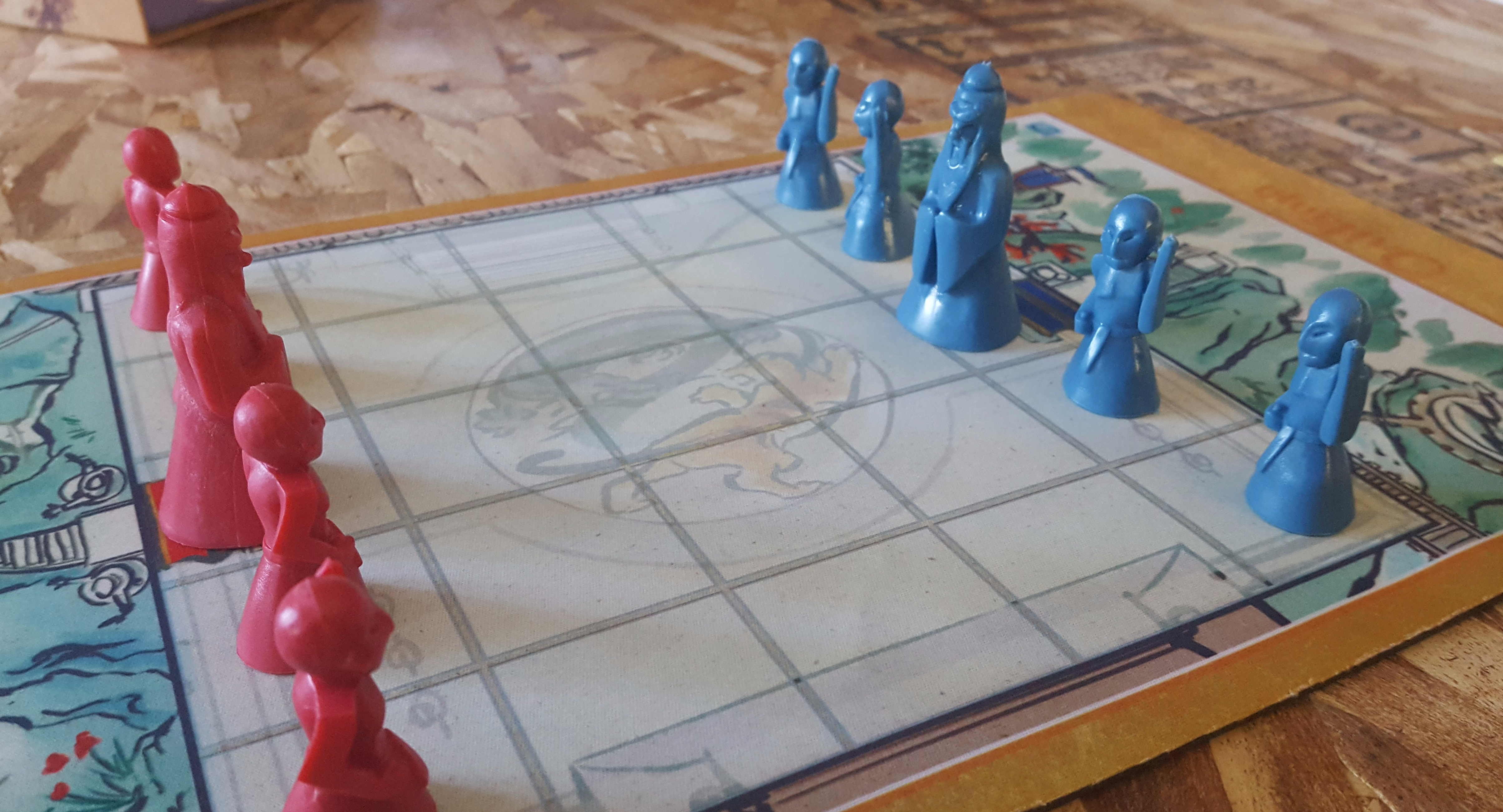
The Shrine of Onitama
Each player then randomly receives two faceup move cards, forming their hand, and a fifth card placed face up near the center of the board. The coloured stamp on the bottom right corner of this fifth card determines which player goes first.
The move cards represent a martial arts technique. They depict a five by five grid, mimicking the game board, with a black square in the centre of it that represents a pawn’s starting square. Additionally, there are coloured squares that show where a pawn could move to, relative to its starting square.
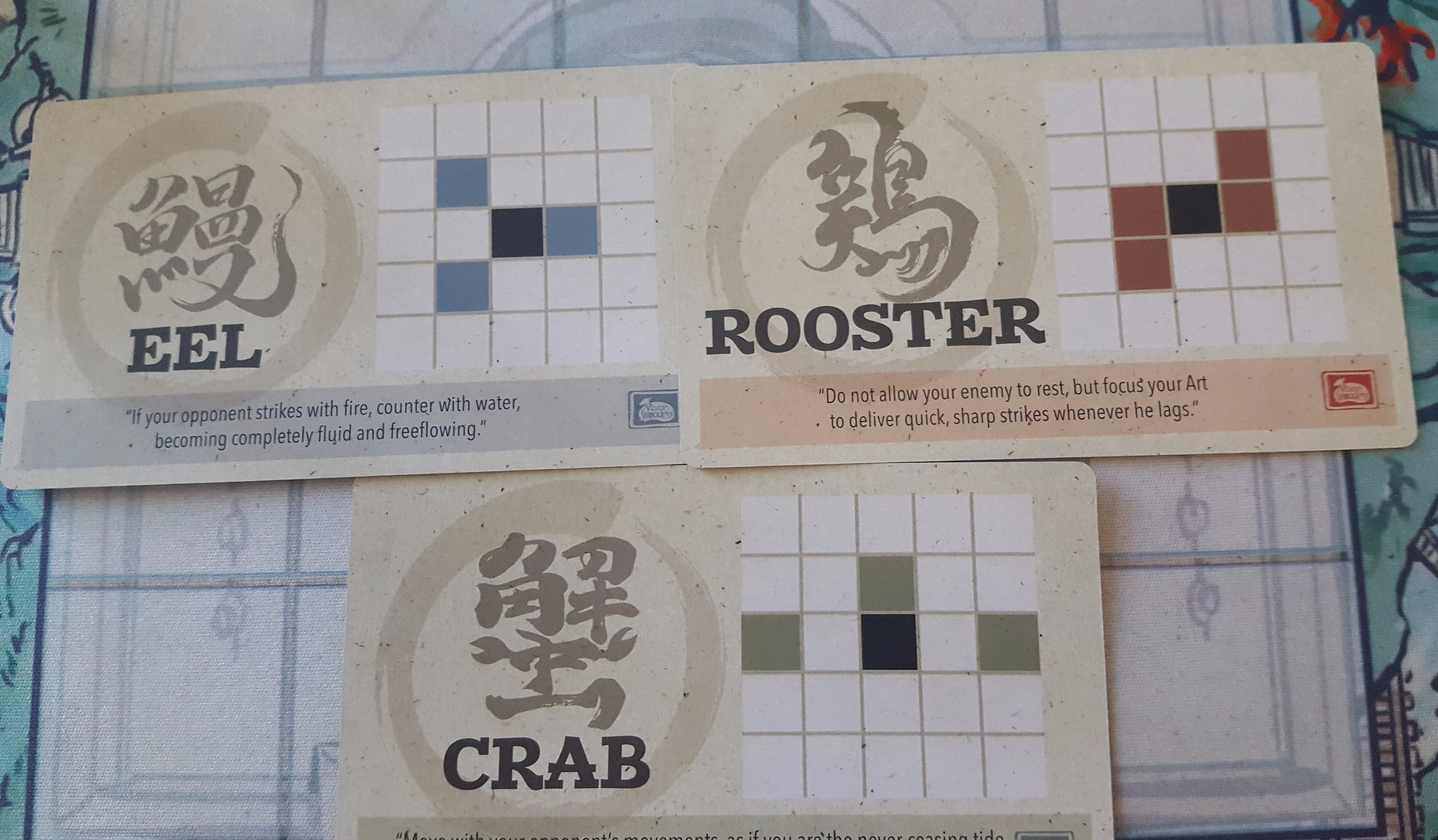
Move Cards
On their turn, a player chooses one of the two cards from their hand, performing the move with their choice of pawn. If the pawn moves to a space occupied by an opponent’s pawn, that pawn is captured and removed from the board. Once they’ve played the move card, they then swap the chosen card with the fifth card that was placed near the board during setup. Players continue doing this until they achieve one of the two win conditions. Speaking of which. . .
Players can win in one of two ways, by capturing the opponent’s master pawn, or by moving their own master pawn onto their opponent’s temple space.
Of these three games, Onitama is the one with the most theme slapped onto it. Take that with a grain of salt obviously, they’re completely abstract afterall. But it is cool getting to play the “Mantis” move card while declaring “Mantis Eats Mate!” or the “Boar” card and yelling “Running Boar Strike!” as you capture a pawn from the board.
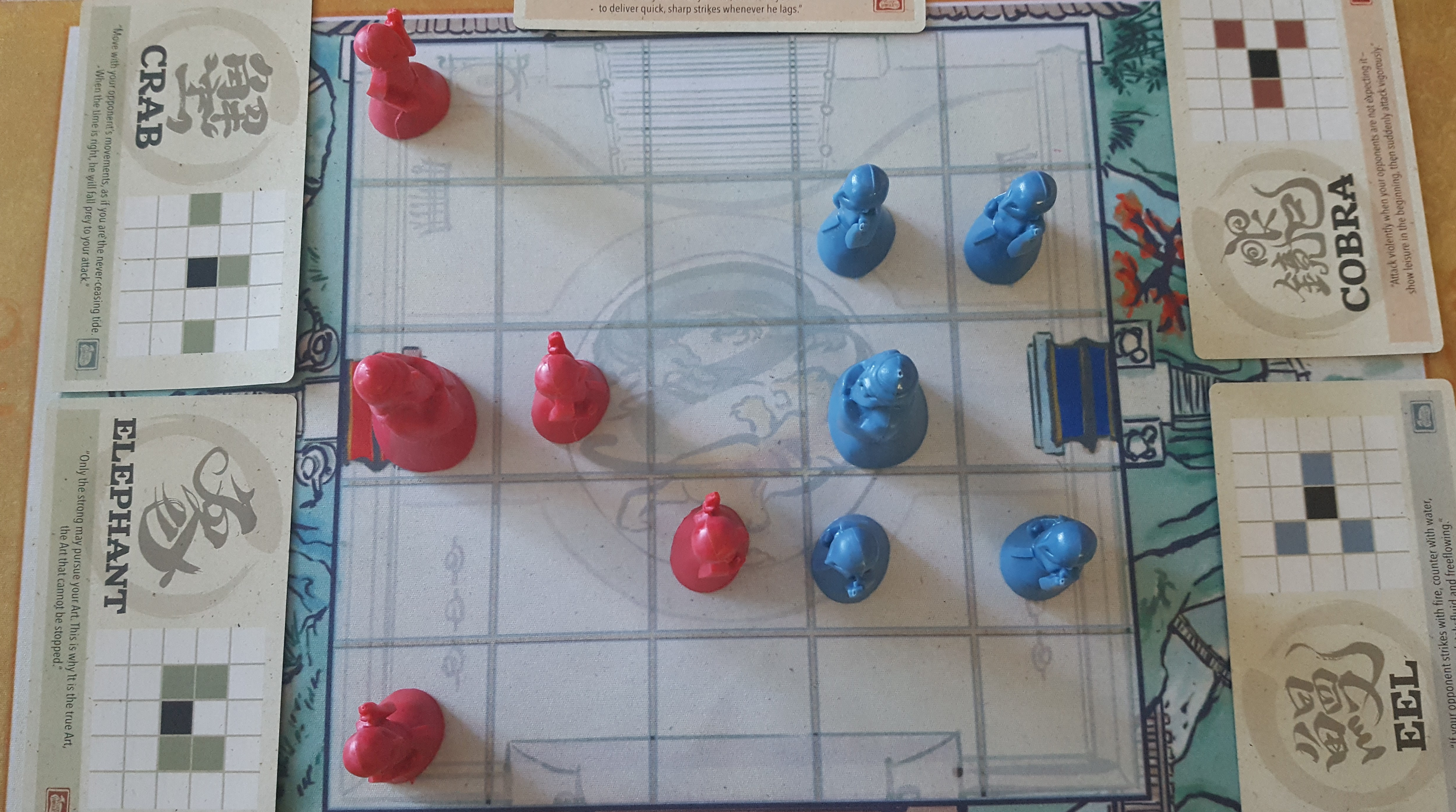
Mighty Elephant Stomp!
Both players see each other’s hands and the possible moves that you need to try to react to. There are sixteen different move cards, so you play with less than half of them every game, which adds some nice variety. A lot of them are the same move, but reversed, which doesn’t take as much away from that variety as you might think. It really comes from figuring out how to make the random cards you get work for you. Some move cards may be “better” or more versatile than others in more situations, and you might have one of those cards randomly dealt to you and get a slight advantage.
You’ll only have that advantage until you play that move card though, handing over that powerful card to your opponent to use against you. The swapping of the played card is very interesting and leads to players having to make some tough decisions. You’ll need to figure out if you gain more from using that card than you lose by handing it to your opponent.
I SUPER suck at this game, and I repeatedly found myself in the situation where I was forced to hold onto a move card just so my opponent couldn’t use it and seal up the game. All because of smart plays from the other player.
The game board is a really nice neoprene mat, which is necessary because of the packaging. You roll it up to fit in the weirdly shaped box. It’s one of those boxes that fills the annoying void spaces on your gaming shelves. It fits well on top of my Shogun box, which is too long to stand upright so it lays on its side, so I’m not complaining. Ok, onto Hive!
In Hive, each player starts with a handful of hexagonal tiles that depict a number of insects. Three grasshoppers, three soldier ants, two beetles, two spiders and a single queen bee. During a player’s turn, they will do one of two things. Either add a tile to the hive, or move one of their existing tiles within the hive. If a player’s queen bee tile becomes completely surrounded on all six sides, that player is defeated.
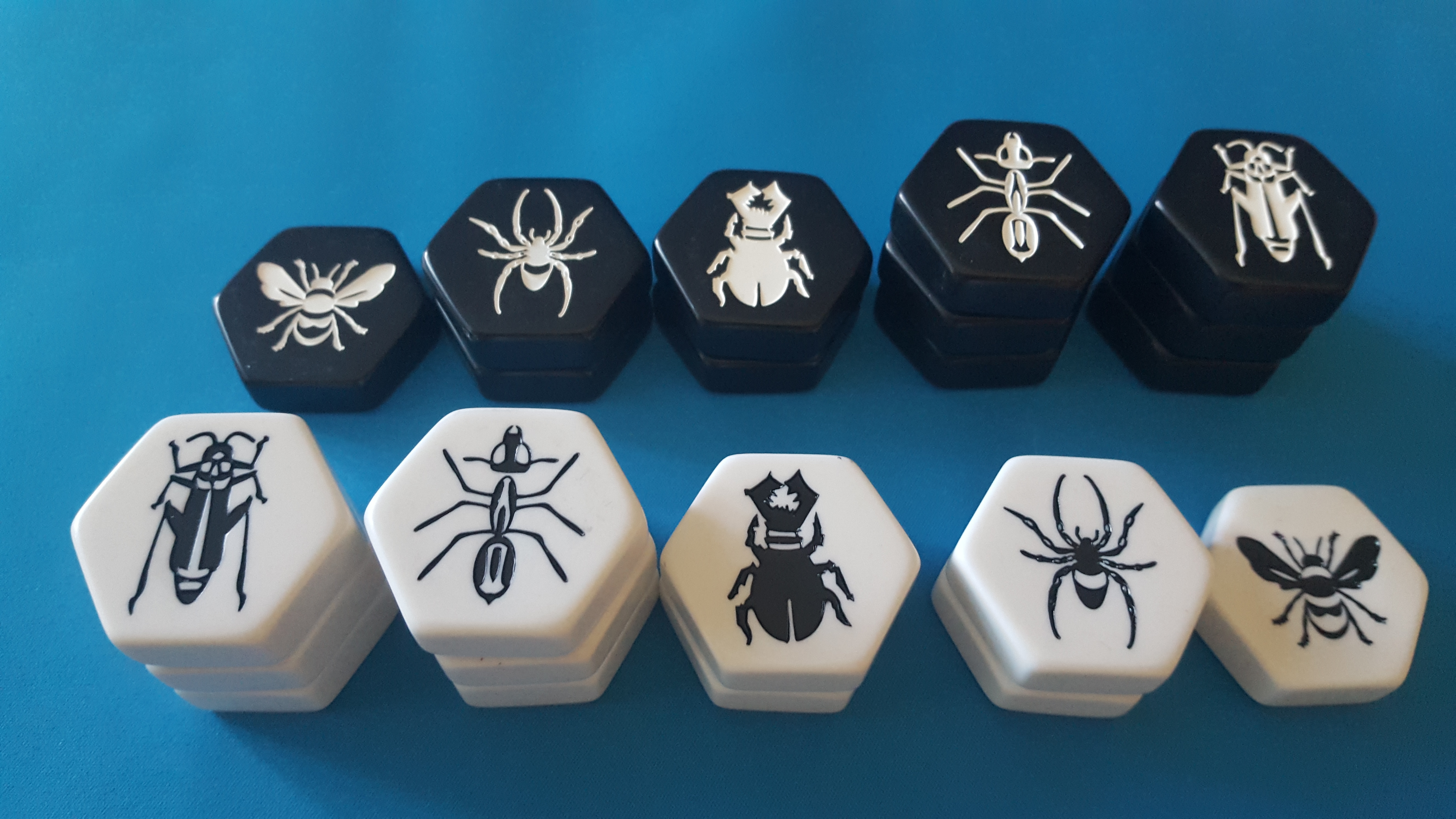
Starting tiles
When adding a tile to the hive, a player may only place it connected to one or more of their own tiles. It can never be placed adjacent to an opponent’s tile. As more tiles are placed, the hive grows larger and larger. This adjacency rule is ignored for the first placement of each player’s tile, otherwise how the heck would you start the hive? Duh! A player’s queen bee must be placed into the hive within the first four turns of the game.
The rules for moving a tile depend on which tile you’ve selected to move. This is where the different types of insects come in. Ex. The soldier ant, definitely the most versatile of the insects, can move any number of spaces around the outside of the hive. There are two restrictions that apply to all tiles when moving. At no point during the movement can the tile become separated, or cause one or more tiles to be separated from the hive. And, if a tile can not physically fit into a space during its movement, then it can not be moved into that space. And that’s the game!
Finally! I’ve found an abstract game that I am damn near undefeatable at! Which definitely pushes me towards the “love it” side of the fence. The real reason I highly enjoy this game is that it just makes me feel good. The tiles are satisfying as hell to play with. The latest edition (third I think?) has resin tiles. I have the Carbon edition, which mean the tiles are black and white. The regular version has coloured insects on the tiles. And there is a cheaper pocket version of the game that, as the name suggest, fits in your pocket so you can take it anywhere. And the quality of the tiles lends to the portability of the game. You could completely submerge them in water and play the game if you wanted to.
The whole concept of the hive and its restrictions lets the players potentially make some very strategic moves to try and block the use of a threatening tile. I could zip my soldier ant all the way around the hive, connecting only to your tile and forming a sort of row. This prevents you from being able to move that tile because if you did, you’d leave my soldier ant behind, separating it from the hive.
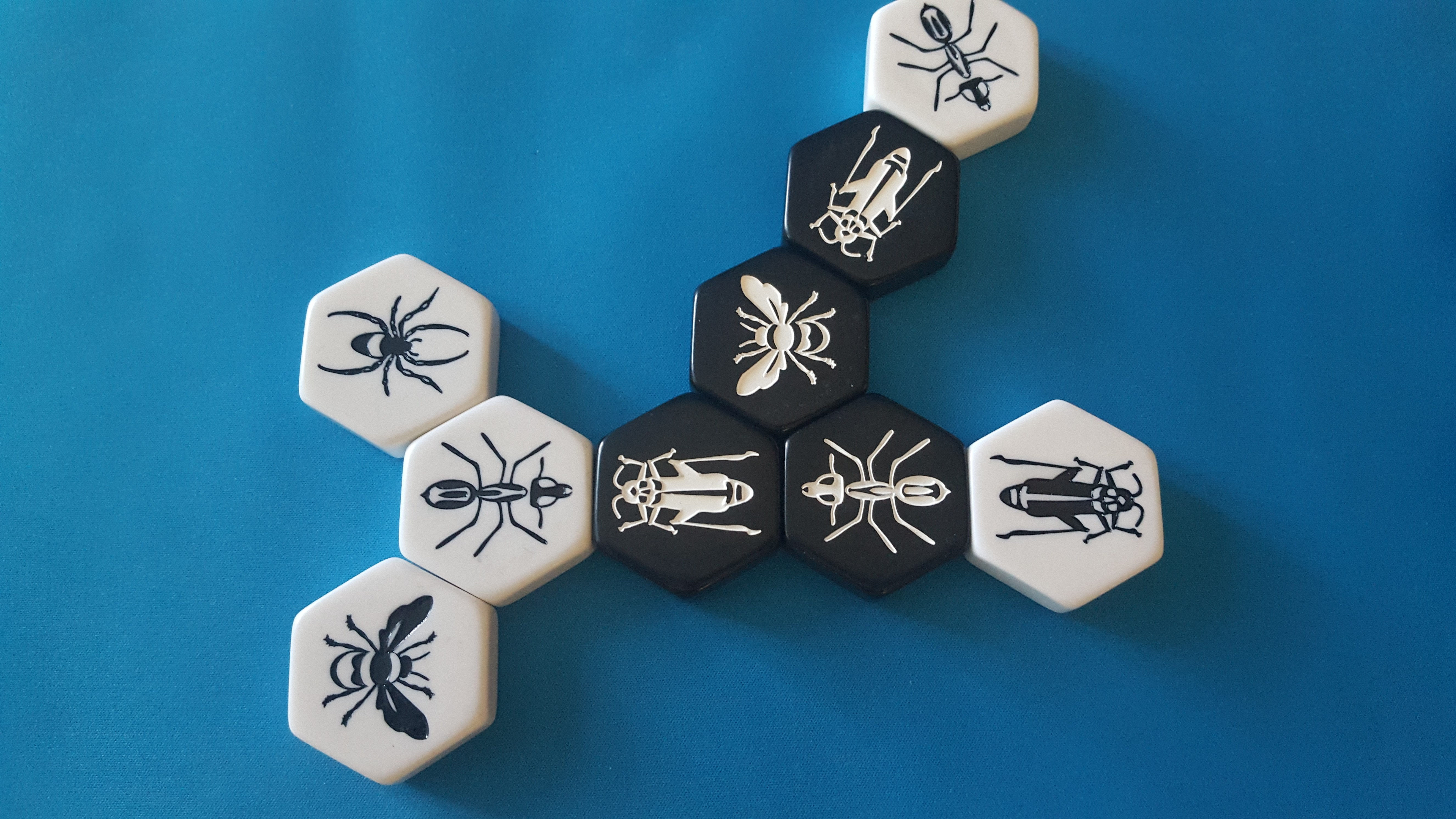
White soldier ant blocking the black grasshopper from jumping next to the queen bee
The placement restriction just makes sense when you’re adding a new tile to the hive. If you could add them anywhere you wanted, you’d just keep throwing them down adjacent to your opponent’s queen bee. That’s not even a game. I like how you could leave yourself in the situation where you have all of your other insect tiles in the hive tied up amongst your opponent’s, with just your queen bee kind of in the open. She’s safe right now, but you need to add more tiles. Meaning you have to add them adjacent to your queen bee, which diminishes how safe she really is since it doesn’t matter whose tiles are around the queen bee. Once she’s completely surrounded, it’s game over man!
There are some expansions out there that give you some new insect types. The Carbon edition I have came with the ladybug and the mosquito. They’re cool to have, but not entirely necessary in my opinion. I think there’s a ton of variety in strategies you could employ. And since the hive is always morphing and moving, your choices and calculations for the optimal move do too.
My favourite tile is probably the beetle. It can only move one position, but it can climb on the hive, adding an extra physical depth to it. The tile that it climbs up onto is blocked and can’t move until the beetle moves off of it. I just picture this fatty beetle lumbering around pinning down the ants and spiders as they squirm and wriggle underneath them. The beetle can even pin down the queen bee, which is a real bitch! Like I said, I just feel good playing this game, win or lose. But now, onto my favourite game of the three.
The Duke is definitely the most chess like of these three games. The game board is a six by six square grid. The players start with their Duke tile and two Footman tiles on the board, the rest of their troop tiles are kept in a draw bag. The Duke tile starts on one of the two middle squares of the outer row of the board. The players then place their Footman tiles orthogonally adjacent to the Duke in a configuration of their choosing.
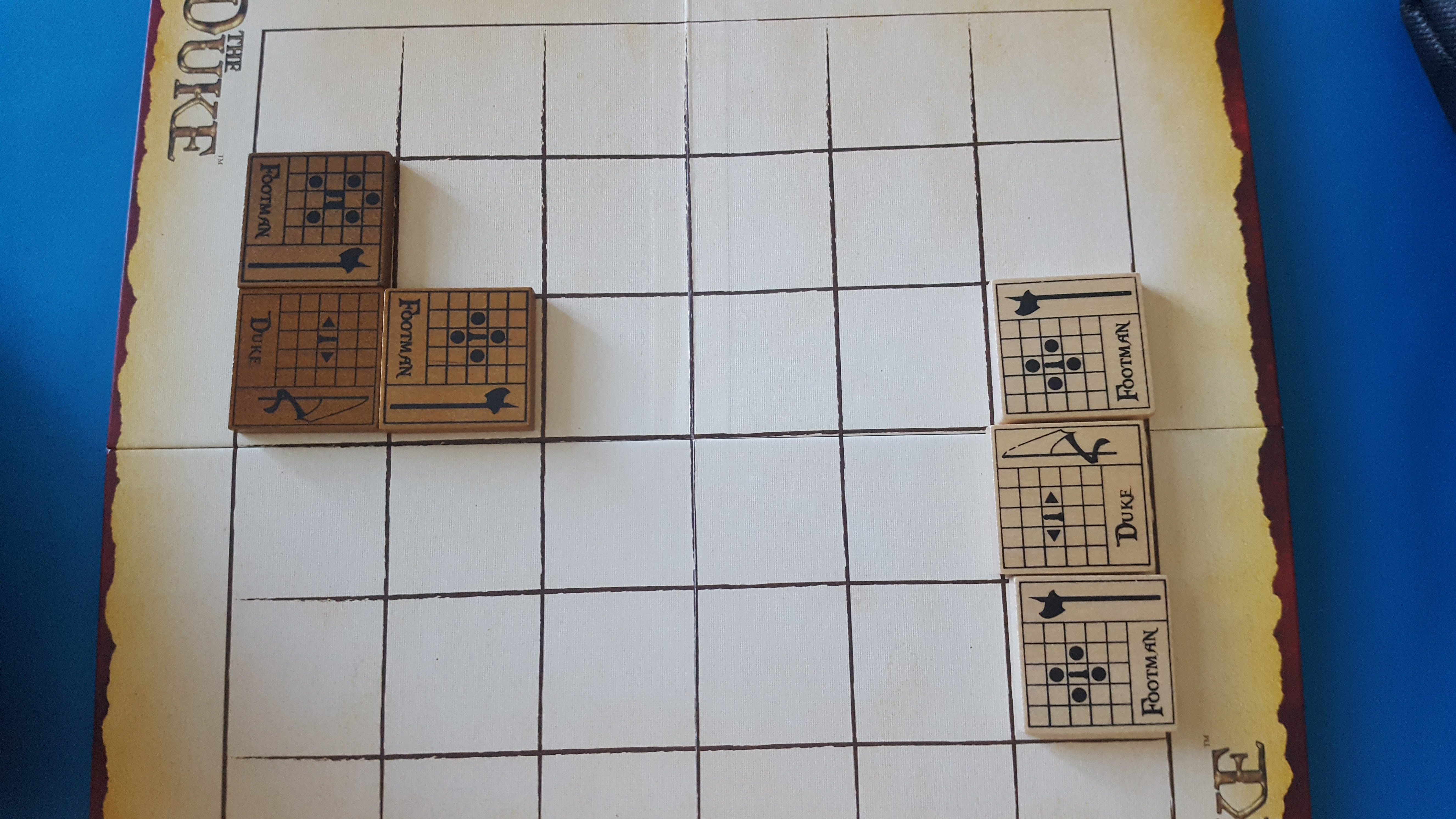
Setup for the beginning of the game
The front of each troop tile depicts a five by five grid, with a black starting side icon in the middle of it. Depending on the type of troop, the tile will depict different types of symbols.
Ex. A filled in circle means the troop tile can move to that square as long as their path is not obstructed by another tile. A filled in triangle means the troop tile can slide any number of spaces in the indicated direction as long as its path is not obstructed. A troop tile will have multiple symbols on it, giving the player a choice of which target square to move to.
On their turn, players may draw a new troop tile and add it to the board, or they may move one of their troop tiles. When drawing a new tile, randomly select one from the draw bag and place it orthogonally adjacent to your Duke tile with the starting side icon face up. If there are no empty spaces available, then you may not draw a new tile.
If a player moves a troop tile, they choose one of the target squares to move that tile to. If an opponent’s tile occupies that space, it is captured and removed from the board. Every time a tile is moved it is then flipped over, revealing a new set of movement symbols.
If a player captures their opponent’s Duke, then they are declared the victor.
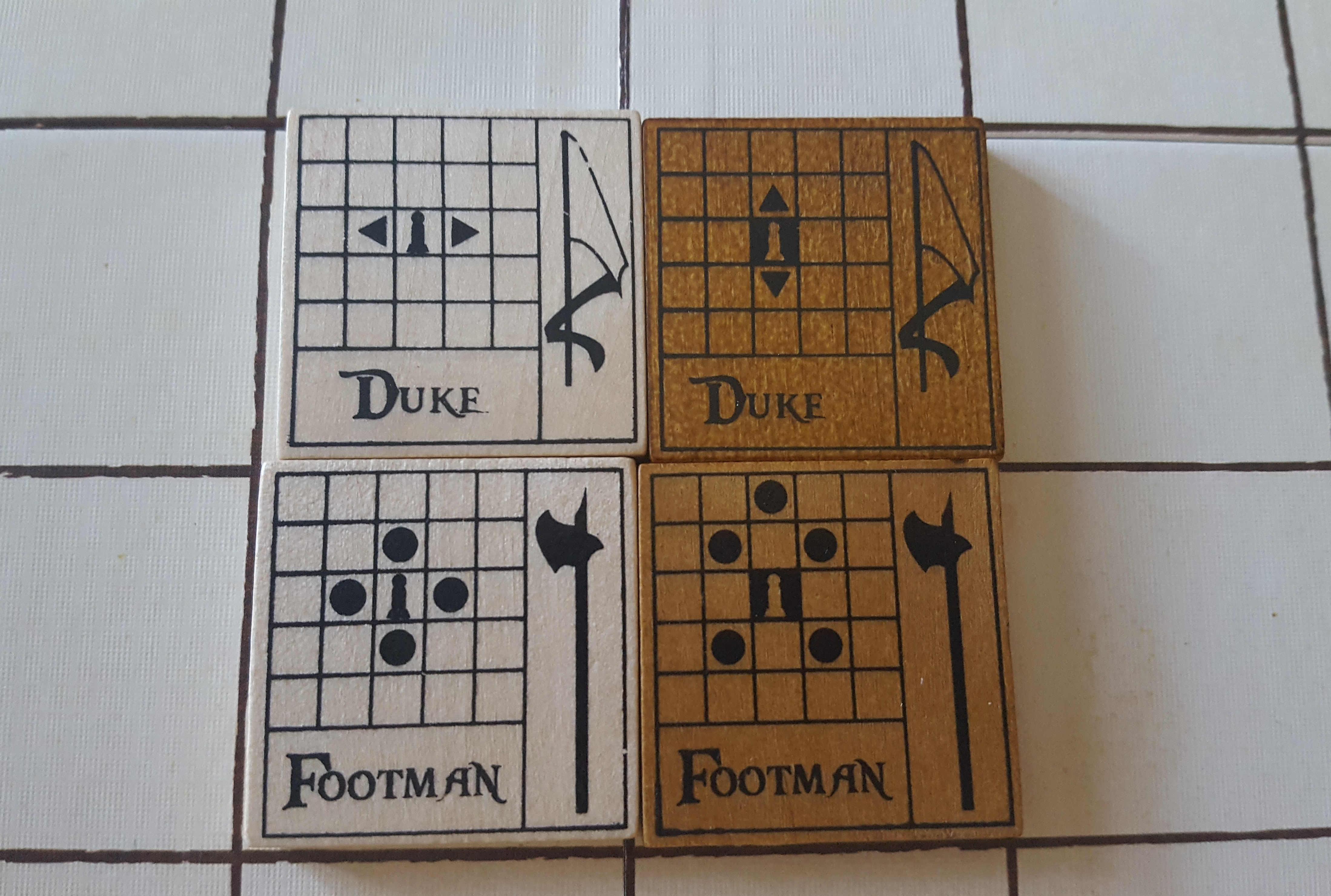
Different moves on the other side guys! LOOKIT HOW COOL!
This is my favourite of these three games by far. I’ve had many three and four hour sessions of game after game after game. And I lose almost every. Single. Time. But I still love this game! It’s so clever. The flipping of the tiles after movement is incredibly awesome. As cool as some of the tiles are, my favourite thing to do is take the Duke and zip him around the board. The Duke’s starting side has horizontal slide arrows, letting you zip left or right across the board. Then you flip it and have vertical slide arrows, allowing the Duke to fly up to the top of the board and pick off any scragglers your opponent left up there.
You can probably see how mobile the Duke tile is, very different than a King piece in chess. An easy comparison to make since they both serve the same purpose in their respective games. There’s a certain thrill in running your Duke head first at your opponent’s tiles knowing that you can get out of danger pretty easily. I always find myself getting a little complacent with how safe I think my Duke is though. It just takes one decent pull from your opponent’s troop bag to put the Duke in danger again.
That’s one thing this game has that the other two games don’t, a luck component. Some troop tiles are definitely better than others. If you mange to pull out the Wizard tile, you’re sitting pretty, that tile is damn powerful! You can mitigate the luck by smart play, of course. Keep your Duke protected, try not to let it get boxed in. And the luck can swing in your favour too, so it’s not that big of a deal.
There are a bunch of expansion packs with new tiles and rules too. I have a pretty cool siege weapons one that replaces some of the base game tiles with trebuchets and ballistas that blast tiles from across the door. Again, not entirely necessary in my opinion, but always nice to have the option to get some extra stuff.
So! What if you could only pick one of these three to get and play? Well, I’d recommend Hive, despite The Duke being my favourite. To me, it seems like it’s the most accessible and widely appealing abstract game of the three. Plus its portability and durability are both huge bonuses. But hopefully I’ve given you a good enough rules overview and gameplay explanation to make up your own mind. Thanks again Reader! Stay tuned for the third and final installment of the Two Player Showcase where I move back to some card driven games with Jaipur and 7 Wonders Duel. And I’ll go over some honourable mentions that I think are worth checking out. See you then!
L.

